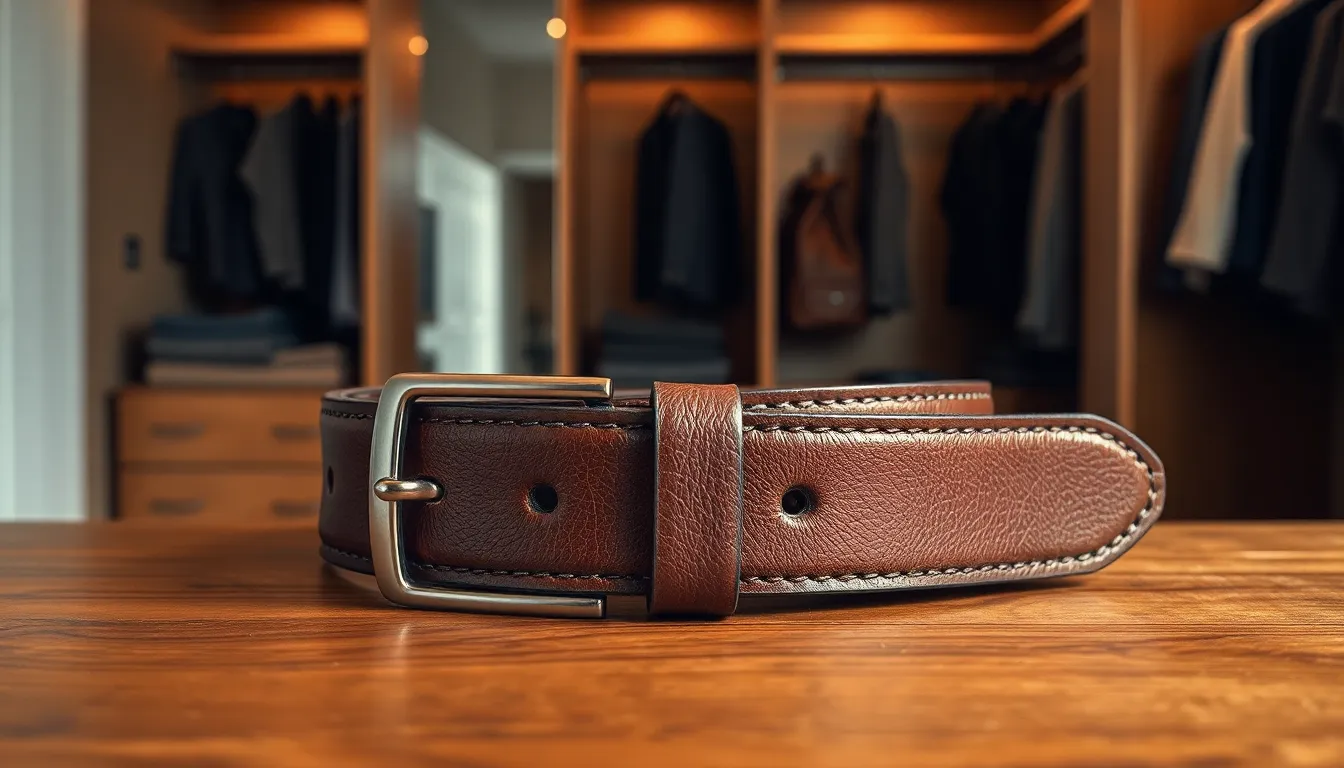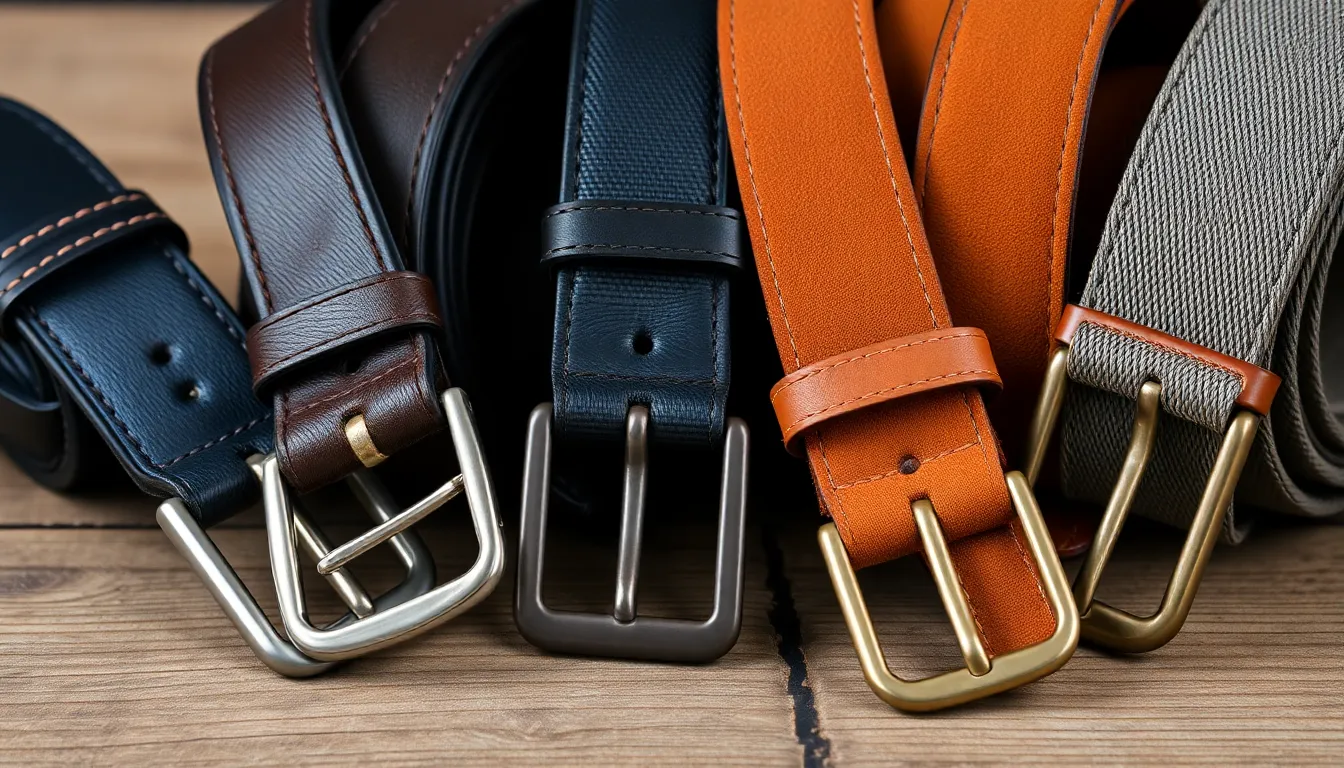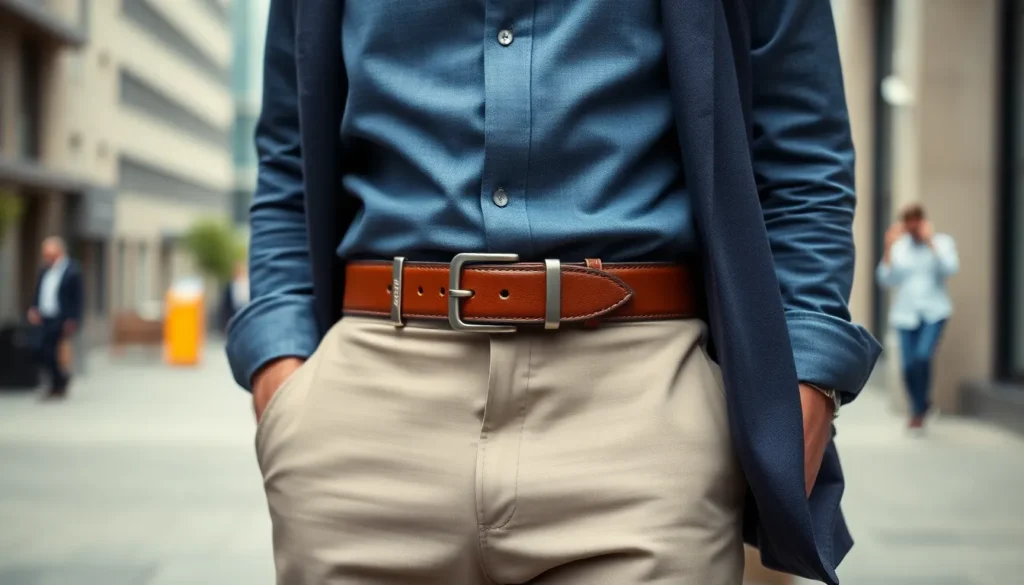Table of Contents
ToggleClassic belts are more than just functional accessories; they’re timeless pieces that can elevate any outfit. Whether it’s a tailored suit or a casual pair of jeans, the right belt can tie a look together and showcase personal style. With various materials and designs available, classic belts offer versatility and sophistication that never go out of fashion.
In a world where trends come and go, classic belts remain a staple in wardrobes everywhere. Their enduring appeal lies in their ability to blend seamlessly with different styles while providing practicality. From leather to canvas, the choices are endless, making it easy to find the perfect belt for any occasion. Discovering the nuances of classic belts can transform not just an outfit, but also how one feels when wearing it.
Overview of Classic Belts
Classic belts serve as vital accessories that enhance the functionality and aesthetic of any outfit. They provide support for trousers while contributing to overall style. Classic belts come in various materials, including leather and fabric, with each type offering unique characteristics and appearances.
Leather Classic Belts
Leather belts remain the most popular choice due to their durability and elegance. They typically feature a smooth surface that presents a polished look suitable for formal occasions. Quality leather belts, such as those made from full-grain leather, exhibit natural variations in texture, adding to their charm.
Fabric Classic Belts
Fabric belts provide a casual alternative and often feature vibrant colors and patterns. These belts might include denim, cotton, or woven options, allowing for versatile styling. Fabric belts excel in comfort and fit, making them a perfect option for everyday wear.
Buckle Designs
Buckle designs vary, influencing both style and functionality. Classic metal buckles often feature simple shapes and finishes, suitable for formal settings. In contrast, contemporary belt styles may incorporate interchangeable buckles, adding personalization and versatility.
Sizing and Fit
Choosing the right size is crucial for the optimal appearance and comfort of classic belts. Belts should typically fit within the range of two to three inches above the waist measurement. A proper fit ensures that the belt serves its purpose while enhancing the silhouette.
Care and Maintenance
Proper care for classic belts can extend their lifespan significantly. For leather belts, regular conditioning and cleanings prevent cracking and drying. Fabric belts require gentle washing, as excessive exposure to moisture can weaken their fibers.
Understanding classic belts adds significant value to one’s wardrobe. By selecting the appropriate style, material, and fit, individuals can enhance their overall appearance and confidence.
Materials Used in Classic Belts


Classic belts incorporate various materials, each offering unique characteristics and benefits. Understanding these materials aids in selecting a belt that complements both style and functionality.
Leather Options
Leather remains the most popular choice for classic belts. It provides durability, elegance, and timelessness.
- Full-grain leather: This top-quality leather retains the hide’s natural grain, leading to a rugged yet refined appearance.
- Top-grain leather: Slightly more processed than full-grain, it offers a smoother finish and is often more affordable.
- Genuine leather: This option combines layers from multiple hides, making it less durable than full or top-grain but still suitable for casual use.
- Suede: Made from the underside of leather hides, suede offers a soft texture and a different aesthetic, ideal for dressy occasions.
Alternative Materials
Alternative materials provide diverse options for classic belts, catering to various styles and preferences.
- Canvas: This fabric offers durability and a relaxed look, often featuring vibrant colors and patterns, making it ideal for casual outfits.
- Nylon: Lightweight and strong, nylon belts are often used for outdoor activities and sportier styles, available in various colors and designs.
- Synthetic leather: This man-made material mimics the appearance of real leather but often at a lower cost, providing a cruelty-free alternative.
- Metal: Some belts feature metal construction for a unique style, often combined with fabric or leather for added design elements.
Each material serves distinct purposes and aesthetics, ensuring a variety of classic belts suitable for every occasion.
Styles of Classic Belts
Classic belts come in various styles, each serving a specific purpose and enhancing overall outfits. Understanding these styles provides clarity on how to select the right belt for different occasions.
Dress Belts
Dress belts are typically made from high-quality leather or suede, showcasing a sleek and polished appearance. These belts often feature a narrow width, generally around 1 to 1.5 inches, making them suitable for formal wear. Common colors include black, brown, and navy, maintaining a classic aesthetic. Dress belts often incorporate minimalistic buckles, such as single-prong or subtle metal finishes, emphasizing sophistication. Choosing a dress belt that matches the shoe color enhances the overall ensemble’s cohesiveness.
Casual Belts
Casual belts offer versatility and comfort, often crafted from materials like cotton, canvas, or synthetic leather. These belts frequently feature wider widths, typically ranging from 1.5 to 2 inches, allowing for a more relaxed fit. Casual styles embrace bold patterns, colors, and textures, contributing to everyday outfits. Buckles may range from traditional prongs to trendy metal clips or snaps, enhancing the playful aspect of casual attire. Pairing a casual belt with jeans or shorts adds a stylish touch while ensuring functionality.
Choosing the Right Classic Belt
Selecting the right classic belt involves careful consideration of size, fit, color, and design to ensure it complements the wearer’s specific style and the occasion.
Size and Fit
Choosing the correct size and fit is crucial for both comfort and appearance. Belts should sit comfortably at the waist, with the end of the belt reaching the middle hole of the buckle. Typically, a belt size corresponds to the pant size, plus two inches. For example, if the pant size is 32, the belt size should ideally be 34. When trying on a belt, it’s important to ensure that it is snug but not overly tight, allowing for flexibility during movement. Opting for a belt with adjustable sizing options can enhance versatility, catering to fluctuations in body size or style preferences.
Color and Design
Color and design significantly influence the belt’s overall impact on an outfit. Classic colors like black and brown offer timeless appeal, easily pairing with a variety of garments. For a more modern approach, consider belts in navy, gray, or even bold shades to add a pop of color. The design of the buckle also plays an essential role; minimalist buckles suit formal settings, while decorative or patterned buckles enhance casual attire. Additionally, consider the texture of the material—smooth leather exudes sophistication, while woven or fabric belts convey a relaxed vibe. Matching belt color and design with shoes and outfits can create a cohesive look, underpinning the overall aesthetic.
Maintaining Your Classic Belt
Maintaining classic belts ensures longevity and preserves their appearance. Regular care prevents wear and extends the life of these essential accessories.
Cleaning Techniques
- Leather belts: Wipe with a soft, damp cloth to remove dust. Use a leather conditioner monthly to prevent cracking and maintain suppleness.
- Fabric belts: Spot clean with mild soap and water. Air-dry to avoid shrinkage or damage, especially for patterned styles.
- Suede belts: Brush gently with a suede brush to remove dirt. Avoid water exposure to maintain texture.
Storage Tips
- Hanging: Store belts on hooks or a belt hanger to prevent creasing. This method maintains their shape and allows for easy access.
- Flat storage: Lay belts flat in a drawer, preventing tangling. This approach protects the buckle and material from deformation.
Inspections and Repairs
- Regular inspections: Check for signs of wear such as fraying, discoloration, or loose buckles. Timely repairs prevent further damage.
- Professional repair: Consult a leather specialist for significant repairs, especially for high-quality leather belts.
Handling Best Practices
- Avoid overloading: Do not use belts as tools to carry heavy items, as excessive strain can lead to stretching and premature damage.
- Seasonal rotation: Rotate belts seasonally to distribute wear. Using different belts prevents any one belt from excessive wear.
Following these maintenance practices helps keep classic belts looking sharp and prolongs their functional and aesthetic life.



